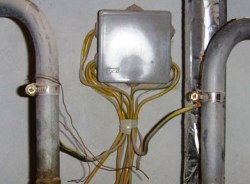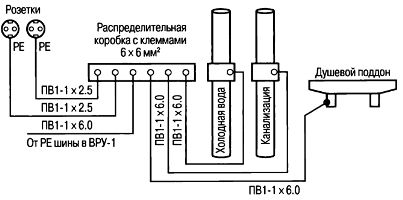Categories: Featured Articles » Electrician at home
Number of views: 261,246
Comments on the article: 11
Equalization Systems
 About the main and additional potential equalization systems and their functional purpose.
About the main and additional potential equalization systems and their functional purpose.
Residential building. Many floors and apartments. Entire kilometers of communications: wires, metal pipes, ventilation ducts, metal hoses and the like. Our apartments have various metal bathtubs, sinks, heated towel rails and you never know what else. In other words, the whole house is simply full of elements and structures capable of conducting electric current, but often not intended for this.
However, each conductor has electrical potential. This is just the law of physics. Potential is a relative value. This means that the electric potential of, for example, the metal surface of the refrigerator in itself does not matter at all. The only important thing is how much higher or lower the potential of the water pipe passes from it (the refrigerator) in relative proximity.
If there is a difference between the potential of the refrigerator and the potential of the pipe, then this difference can be considered voltage. Someone may suggest that such a voltage cannot be significant: after all, both the body of the appliance and the water pipe should not be “out of phase”. But you should not rush to conclusions. In fact, there are so many reasons why even a harmless metal ventilation duct can acquire a dangerously high relative electrical potential.
Among these reasons, for example, not only failure of the insulation of the phase conductors of the cables of the power supply system, but also atmospheric overvoltages, static electricity, stray and circulating currents of grounding systems and much more.
And what to do? How to protect yourself from all these misfortunes and live in peace without fear that one day we will be shocked by our own bathtub?
This issue is decided by the creation of potential equalization systems. Her idea is quite simple. If live parts have a direct electrical connection, then their potential is always the same, and voltage between them will not arise under any circumstances.
Therefore, the potential equalization system includes everything that can become dangerous: namely metal pipes, building metal structures, lightning protection devices, boxes, trays. It all connects to main grounding bus (GZSh) at the entrance of the building. Such a system is called potential equalization system.
But until the engineering communications reach a single apartment located on some high floor, the distance from the main building can become impressive. The laws of electrical engineering, characteristic of the so-called "long lines", will come into force.
In accordance with these laws, the resistance of long conductors cannot be neglected. That is, the electric potential of the same metal pipe at the entrance to the building and on the fifteenth floor can differ, and very much. Thus, the main potential equalization system becomes less and less effective as you move away from the GZS.
Therefore, each apartment has its own additional potential equalization system. Elements that are included in it are connected to the PE bus (or PEN) in the apartment or house panel. This is again water pipes, ventilation ducts, and besides this, bathtubs, sinks and other voluminous metal objects.
Additional potential equalization system in the bathroom
Not every electrician repairing or replacement of apartment wiringknows about potential equalization systems and attaches due importance to them.Therefore, it is better for each homeowner to monitor the condition and quality of the implementation of such a system in their apartment on their own, without hoping for anyone else. After all, this is a question, first of all, of personal security.
Alexander Molokov, https://env.electricianexp.com
See also at bgv.electricianexp.com
:

